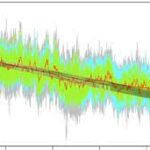Deel 3 van een serie blogs over post-normale wetenschap
Op 16 maart kondigde ik in dit artikel een serie blogs aan over post-normale wetenschap, mede omdat weblogs zoals deze volgens de bedenkers van het concept een cruciale rol in deze nieuwe tak van sport spelen (zie artikel). Ik wil de discussie warmdraaien met enkele eenvoudige inleidende blogs, zoals de eerste die een voorbeeld gaf van peer-2-peer review door een niet-wetenschapper. Vandaag weer een makkelijke: ik wil bovenstaande clip over de antibiotica resistente bacteriën uit het 8 uur journaal van woensdag vasthouden als ankerpunt van een “normaal” ernstig probleem.
Normale problemen heb je in de “normale wetenschap” en dat begrip halen Ravetz en Funtowics, de bedenkers van de post-normale theorie, van Thomas Kuhn:
The Structure of Scientific Revolutions (SSR) was originally printed as an article in the International Encyclopedia of Unified Science, published by the logical positivists of the Vienna Circle. In this book, Kuhn argued that science does not progress via a linear accumulation of new knowledge, but undergoes periodic revolutions, also called “paradigm shifts” (although he did not coin the phrase), in which the nature of scientific inquiry within a particular field is abruptly transformed. In general, science is broken up into three distinct stages. Prescience, which lacks a central paradigm, comes first. This is followed by “normal science“, when scientists attempt to enlarge the central paradigm by “puzzle-solving”. Thus, the failure of a result to conform to the paradigm is seen not as refuting the paradigm, but as the mistake of the researcher, contra Popper’s refutability criterion. As anomalous results build up, science reaches a crisis, at which point a new paradigm, which subsumes the old results along with the anomalous results into one framework, is accepted. This is termed revolutionary science. Bron: Wikipedia.
In het volgende artikel zien we hoe Ravetz en Funtowics hun post-normale wetenschap definiëren en rechtvaardigen voor de situaties waarin Kuhn’s schema niet meer werkt. Nu gaat het erom om te zien dat de kwestie van de ESBL-vormende resistente bacteriën een klassiek “normaal” probleem vormt. Er is echt iets aan de hand. Concreet en tastbaar en in het nu liggen er geïnfecteerden in het ziekenhuis. Gelukkig bestaan er rondom infectie en resistentie volwassen onomstreden theorieën. Het paradigma staat. Alle nieuw gevonden puzzelstukjes – geruststellend of onrustbarend – passen netjes binnen dezelfde uitdijende puzzel. Nergens een vreemde ophoping van “epicirkels” te bekennen. Hier is uitstekend beleid op te bouwen zonder dat er een “consensus” en grote massale conferenties nodig zijn. Een kleine bijeenkomst van wijze vrouwen en mannen volstaat. En die is woensdag geweest (zie bovenstaande video en artikel NRC). De “normale” wetenschap kan zijn werk doen en verdient ook zonder meer dikke overheidssubsidie.






Zonder helaas de definitie ervan te kennen, begrijp ik de term "peer-to-peer review" niet. Hoe verschilt die met de term "peer review", behalve daarin dat de eerste term mij een tautologische variant lijkt van de tweede. Een "peer" is een "gelijke", een "evënknie". Een peer review is dus een beoordeling van iemand die gelijk is aan de schrijver; een peer-to-peer review lijkt mij een beoordeling van de ene gelijke aan de andere gelijke: hoe verschilt dat met de eerste definitie, behalve in de tautologische formulering? Als bedoeld wordt dat de beide peers zich rechtstreeks tot elkaar richten, zonder anoniem voor elkaar te zijn, dan verdient dat een duidelijker term. Kan de bedenker van de term hier eens (peers-gewijs)op ingaan?
Het begrip "peer-2-peer" komt oorspronkelijk uit de wereld van het illegale downloaden (voor zo ver ik uit mijn hoofd kan nagaan). Download sites met een centrale server zoals napster waren juridisch kwetsbaar: ze konden wegen illegale activiteiten worden gesloten. Als reactie ontstonden de peer-2-peer netwerken waarbij de muziek nooit op een centrale server wordt verzameld, maar altijd diffuus bij de peers op hun harde schijven staat. Als je op zo'n peer to peer service zoals limewire inlogt, dan zie je hoeveel andere peers online zijn en zie je per liedje wat je donwload van hoeveel peers je de bits en bytes ontvangt. Nog complexer wordt het met torrents, maar dat is ook een vorm van decentrale peer-2-peer uitwisseling. Het is dus de overgang van het hierarchische client-server model naar een wereld waarin alle peers gelijk zijn.
Nu dan mbt de toepassing in post-normale wetenschap: Funtowicz en Ravetz gebruiken niet peer-2-peer review maar "extended peer review". Misschien een betere minder verwarrende term. Peer-2-peer review komt uit dit artikel over Patrick Courrielche: http://climategate.nl/2010/01/14/peer-review-is-d…
Feit is dat binnen het model van peer review en publicatie in de journals absoluut nog een ouderwetse hirarchie bestaat. Het risico van "pal review" is enorm. Logisch dat jij iemand helpt die jou heeft geholpen. Het gaat om grote reputaties en enorme bedragen. Hoe anders is dat op de blogs waar reageerders zonder enig belang met de wereld delen wat zij in hun brein hebben bekokstoofd.
Dat noemen we dus peer-2-peer review: dat elke hierarchie en vriendjespolitiek is ondermijnd door de kracht van internet. Iedereen kan zijn zegje doen. Net als op Wikipedia (kleine gevallen van corruptie zijn bekend – juist ook op klimaatgebied – maar grosso modo werkt het). Het is geen democratie maar een meritocratie: wie het vaakst en het meest informatief reageert wordt gehoord.
In volgende blogs ga ik verder onderzoeken of dit nu een trendy hype is of een blijver. De bedenkers van het concept post-normale wetenschap vergelijken het als cultureel fenomeen met de opkomst van de vakbonden..